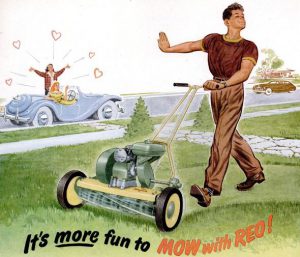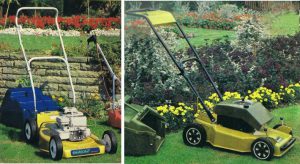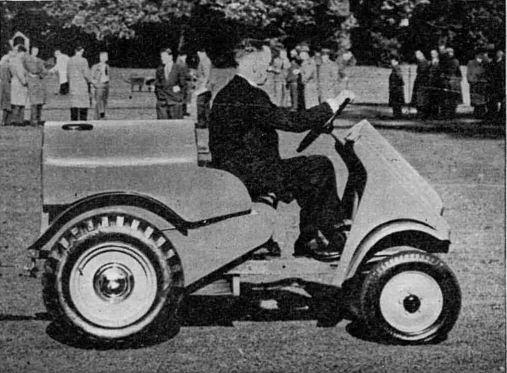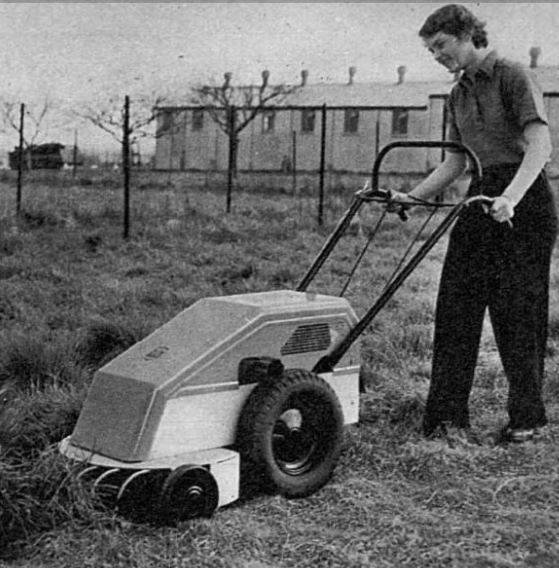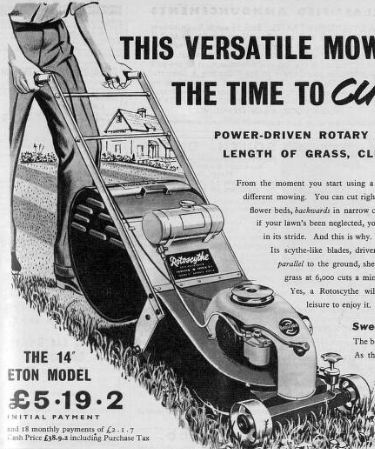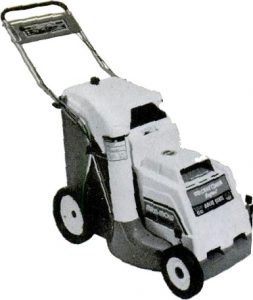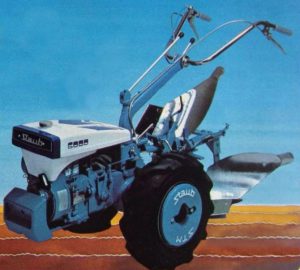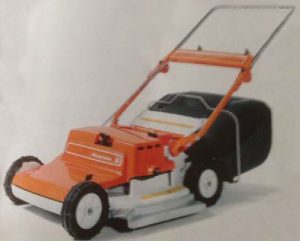When Machines Go Modern
August 2, 2017 in Articles, Machinery
Manufacturers would go to great lengths to promote their machines with colourful advert and brochure images as in the image on the right, and also marketing tactics such as special HP deals or perhaps promoting new machine innovations to outperform the competitors. It didn’t just stop at advertising either, on the whole manufacturers were generally looking to the future, making their machines more efficient, lighter, more cost effective to manufacture, buy and run.
At least a few designers were looking to leave their competitors behind by creating machines that had a modern look. These new designs may have looked updated and modern on the outside but sometimes the actual mechanicals were the same under the tin work as the previous models – the public doesn’t mind as long as it looks like a new model. Some machine designs were becoming squarer and angular and there are quite a few machines that demonstrate that – some may not have made it past the mock-up stages or got to market.
This article does showcase the skill of the designers and their ability to produce (mostly) an aesthetically pleasing machine. Below are machines with some inspired and interesting design to their tin work.
As an example of marketing: The image on the right shows two Qualcast mowers from 1979. The mower on the left is a “Standard” Jetstream with a 3hp Briggs and Stratton engine, 18″ cut and and 4 height adjustments, retailing at £113.45.
The mower on the right is a modern looking Qualcast Jetstream De-Luxe rotary mower, retailed at the same time as the “Standard”, powered by a slightly larger 3.5hp Briggs and Stratton engine but with the same 18″ cut, this had a retail price of £135.00.
That equates to a £20.00 premium for the more modern De-Luxe design of the Jetstream – they’ll both cut the grass exactly the same, and the engines will both have intermittent hissy fits but doesn’t the more modern design look better, sleeker, impress the neighbours more and worth the £20 increase? Argos actually had it on offer in 1979 at £109.99 vs £99.99 for the “Standard” making it even more of a bargain.
Another machine shown in the image below that doesn’t seem to have dated much through the decades is the Garner industrial tractor when fitted with the optional full body tin work. Even today the addition of the tin work makes it look a smart machine, the designers obviously thinking about how the final machine will look and the attention to how the bodywork is sculptured. I still haven’t seen one of these fully-kitted out tractors or an image on the internet yet, perhaps the optional tin work was expensive? The image below shows one being exhibited in 1954 at the National Association of Groundsman’s Exhibition at The Hurlingham Club, London. The VHGMC have a Garner register here.
Even John Allen & Sons created modern designs, a huge leap away from the Allen Scythe is a 1955 Allen Rotary Sickle, shown below. This machine was powered by a 2-stroke engine (potentially 2.5 hp from other reports) with kick start. Excellent for dealing with “neglected grassland and hedgerows” it had a handlebar extension to use when taking a first cut at tall, rough grass. price was £67 15s. A fairly modern enclosed design, the top cover is hinged at the front and lifts up to reveal the engine and workings, but what were the colours and livery of the tin work? Again another machine that has proved elusive.
Some designs went very angular, or the designer got carried away with his ruler and set square. Shown is the Auto-Culto 55, it was a boxy machine with the tin work being an interesting design decision, the flat top perhaps being a handy place to put a flask of coffee when having a break. According to newspaper reports the machine was powered by a “four stroke Villiers 150cc engine which develops 3bhp at 3600rpm. It can be used with a variety of attachments.” The attachments included a flexi-drive chainsaw and hedgetrimmer. Also an out-front rotary mower. Anybody have an Auto-Culto 55 in the back of the shed? The right-side image is from a 1964 Smithfield Show report.
Probably the best know modern design is the Shay Rotoscythe. The image below is a late image from 1955. This machine is visually an excellent piece of design and an ingenious development of the lawnmower too. The mower was also available with ‘moss pegs’, these attached to the mower blade and acted as a scarifier to remove moss from the lawn. The earliest newspaper advert reference the VHGMC has found to the Rotoscythe is from May 1934, the electric model being £11 and the petrol model £19.
Even abroad there were some interesting machines taking on a modern look:
Below is something different and proves that manufacturer did look for something to capture the buyers imagination. Retailed in America in 1978 was the Sears Maxi Mow. A quirky looking machine, this 5 speed self-propelled mower had the added benefit that it would take ordinary black bin bags and the mower would then fill the bags in the rear compartment. This would not work in the UK with our intermittent weather and damp grass, did it work efficiently anyway with it’s vertical grass chute? An interesting design nonetheless, although probably a nightmare to dismantle to service the engine.
In France the Staub cultivators (pictured below) had a makeover moving away from the traditional look of the vintage cultivator that we all know so well.
The 1980’s Staub range are in a striking livery of white, blue, silver and chrome and their appearance has a great presence, it is a surely one to catch the eye in the lineup of machines at a retailers in France. Particularly the 6000 model below from the early 1980’s is a successful overhaul of a traditional machine. In the flesh it is visually faultless – some even have go-faster arrows on top of the white fuel tank!
In Sweden the Husqvarna company was making the MK 500 mower (pictured below) in around the late 1960′ early 1970’s, these mowers were retailed in the UK. This smooth ABS shelled mower was available in two fashionable colours, either a mid-blue colour for the push-version or if preferred there was an identical looking self-propelled front wheel driven model in bright orange, as pictured. The mower was advertised has having “clean, almost streamlined styling…the smooth uncluttered lines making it easier to keep the machine clean and smart“.
Powered by a 120cc (3,5hp) two-stroke engine the mower was described in the brochure as ” Everywhere it has been demonstrated experts have commented on it’s low noise level ‘Environmentally acceptable, agreeable – almost silent’ “. Two-stroke?
It was also stated in the literature that it was ‘Europe’s rarest power mower‘ which is an odd thing to say when trying to sell a product, however, it turns out they were right and 40-odd years later it remains rare, indeed we still haven’t seen one!
Looking back through the images we seem to have chosen quite a few machines that remain rare. The Rotoscythe, the Qualcast Jetstream mower and the Staub tractor in France are available, the others not a sign of them. Have you got one of them?

